Abstract
Immune consequences of gastrointestinal colonization of CD-1 and CBA/J mice with Candida albicans in the presence or absence of continuous antibiotic treatment with penicillin-tetracycline or trimethoprimsulfamethoxazole were investigated. Intubation with C. albicans in the absence of antibiotics resulted in the induction of low but detectable delayed-type hypersensitivity (DTH), demonstrable by footpad testing with a C. albicans wall glycoprotein (GP), and in the stimulation of a moderate level of protective immunity, demonstrable by intravenous (i.v.) challenge. DTH to a membrane extract, BEX, could not be detected in such animals. However, animals colonized in the presence of antibiotics and then inoculated cutaneously prior to being tested for DTH or protective immunity developed significantly enhanced levels of DTH to GP and BEX and were protected to an even greater extent than animals colonized in the absence of antibiotics who were not inoculated cutaneously. The priming effect of colonization, particularly with respect to the antigen GP, was also obvious from an enzyme-linked immunosorbent assay for GP-specific antibody with sera of mice surviving the i.v. challenge, in that GP-specific antibody was present in the highest titers in colonized animals that had been inoculated cutaneously prior to i.v. challenge. While the antibiotics promoted higher levels of colonization, as evidenced by stomach and fecal cultures of intubated mice, antibiotic administration was not necessary for the induction of C. albicans-specific responses. Moreover, contrary to reports in the literature, antibiotic administration had no adverse effect on the immune responses measured. Females were innately more resistant than males to i.v. challenge with C. albicans, but each sex was capable of developing protective immunity of equal intensity in response to colonization or immunization by cutaneous challenge.
Full text
PDF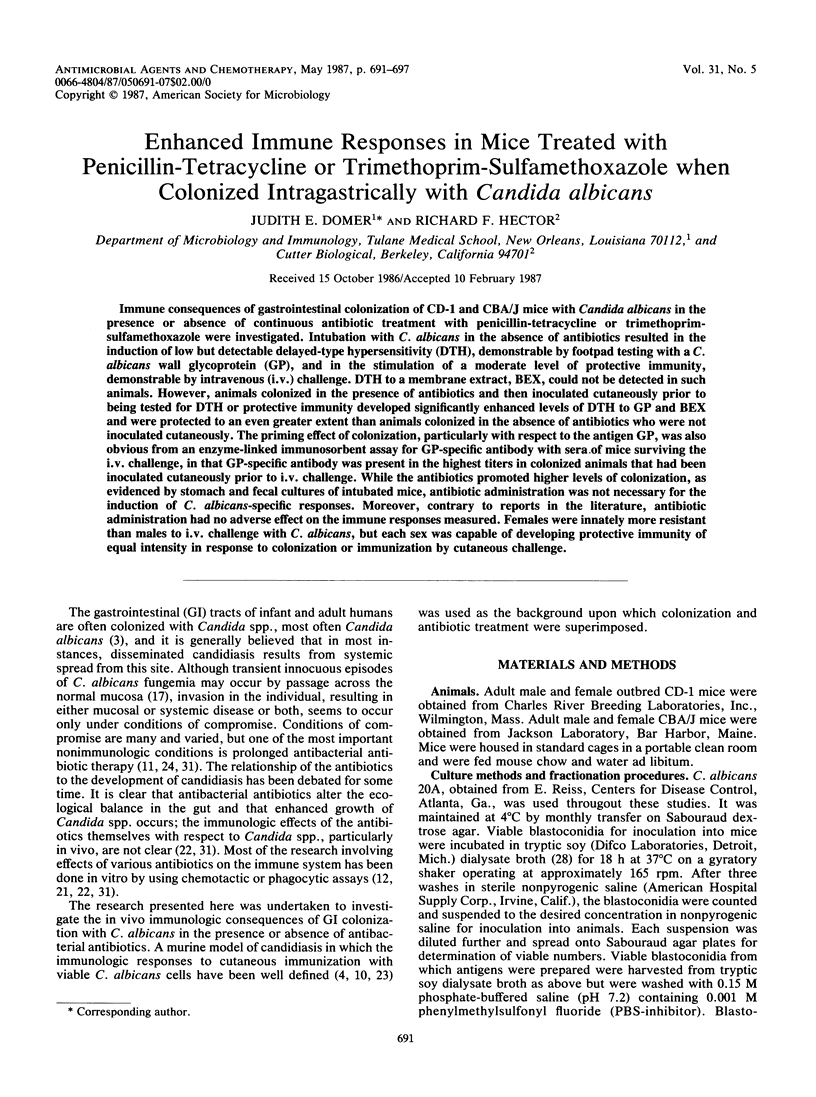
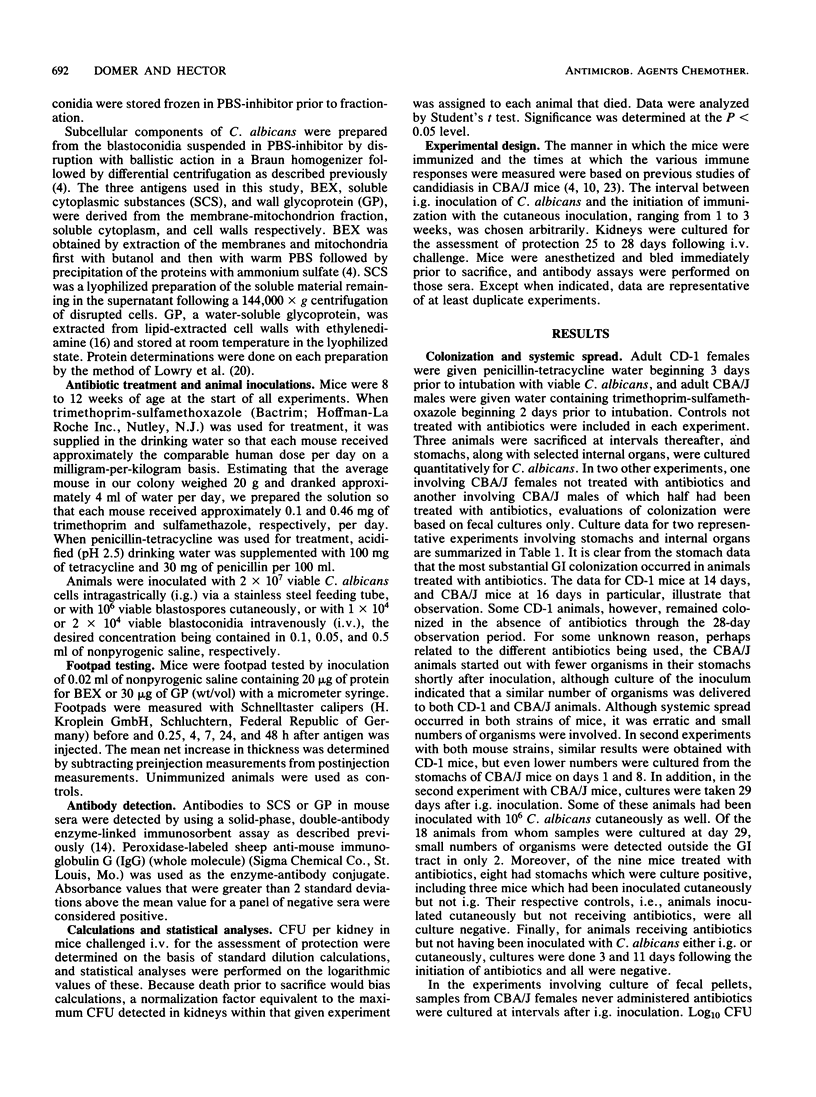
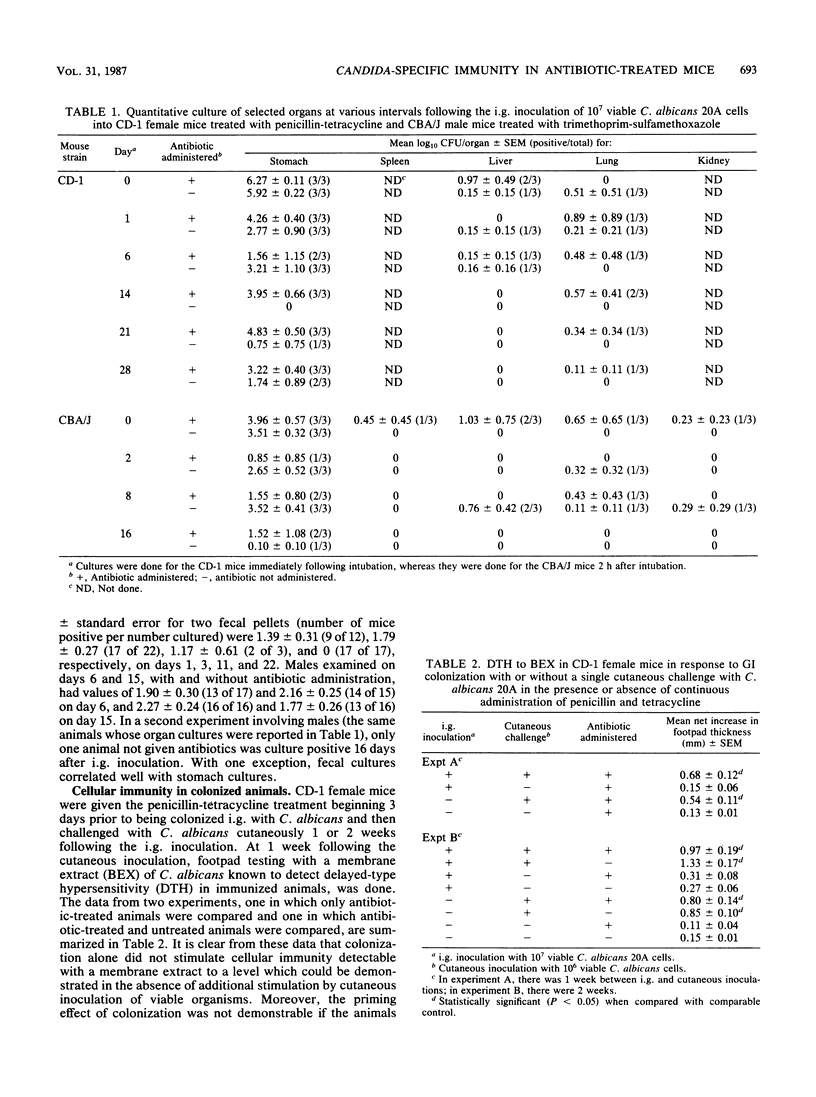
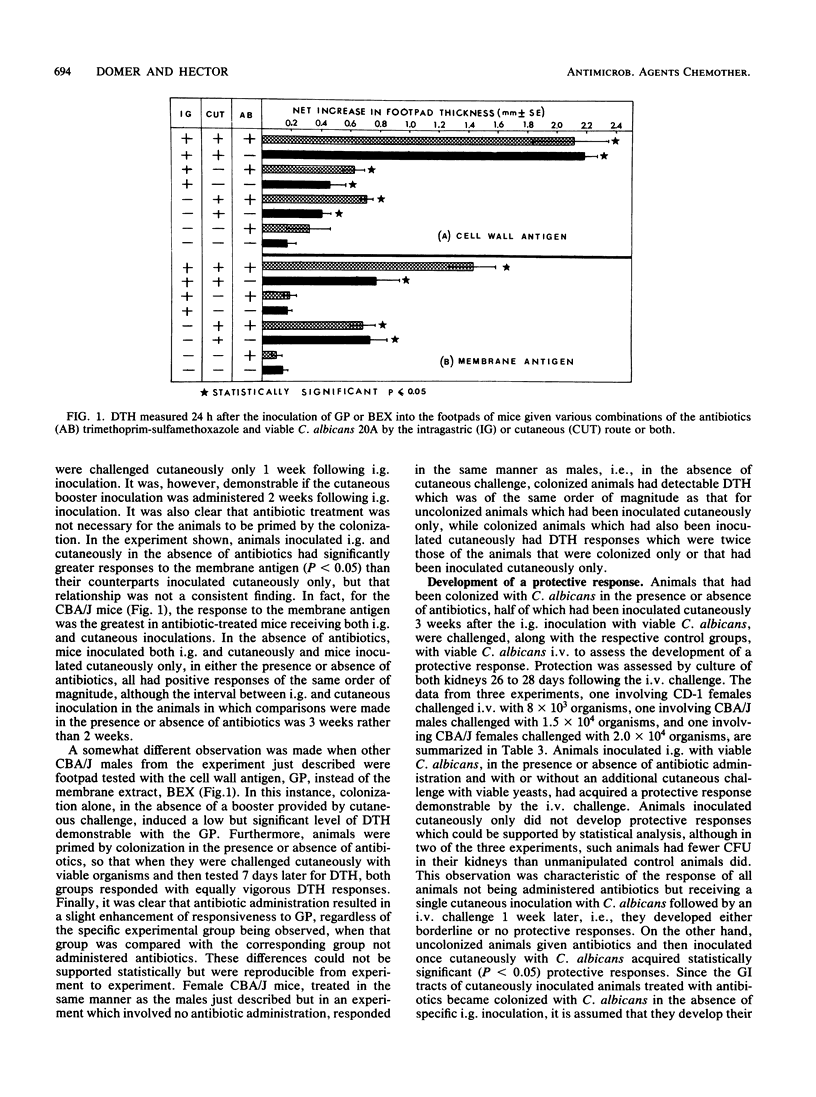
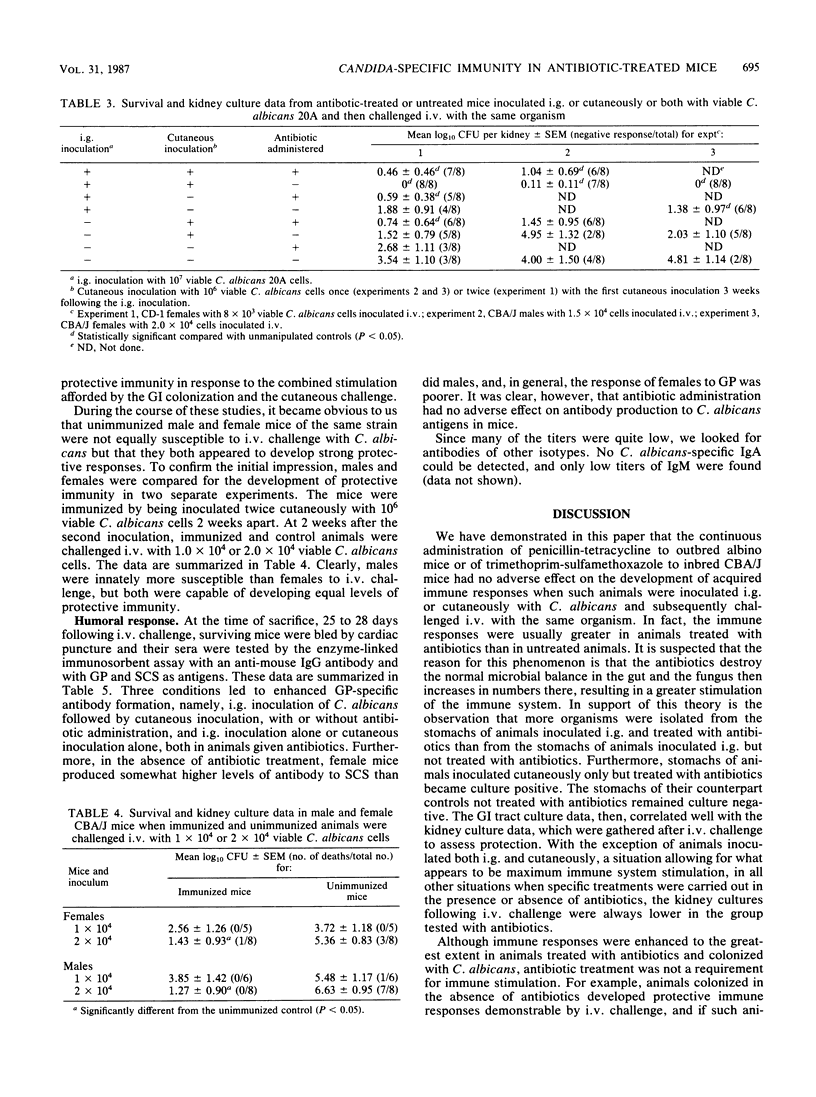
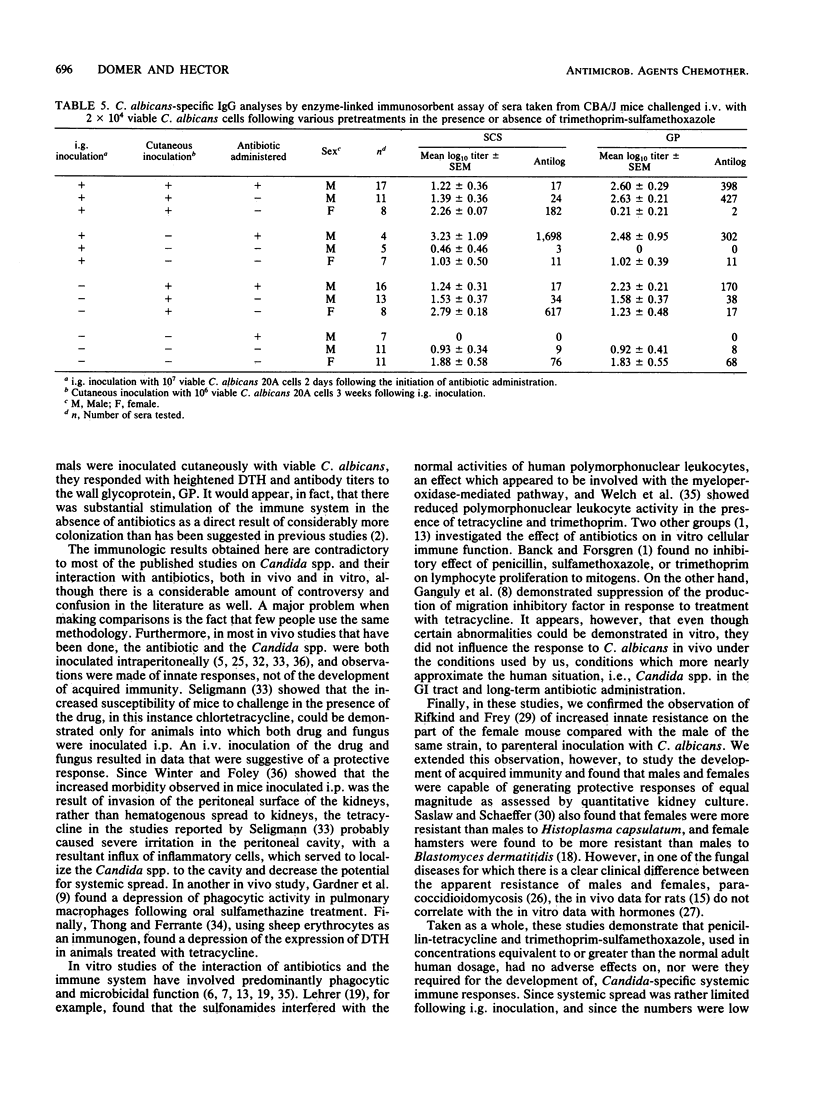
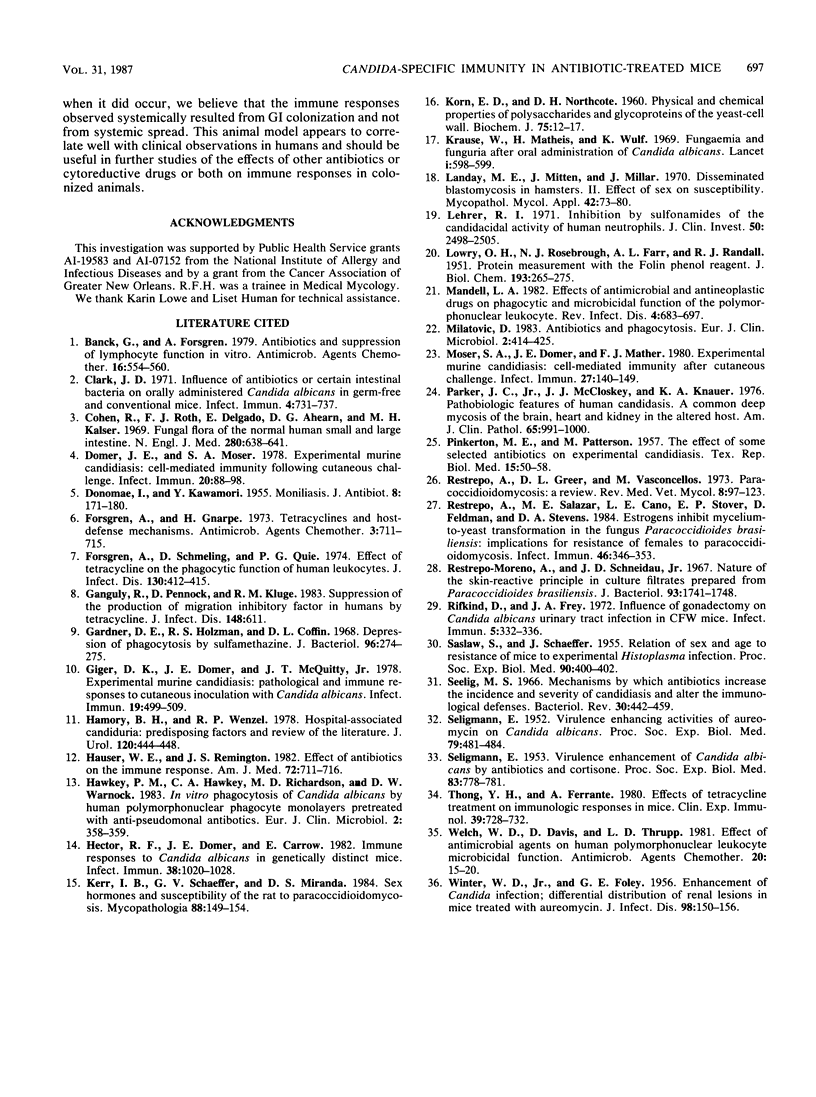
Selected References
These references are in PubMed. This may not be the complete list of references from this article.
- Banck G., Forsgren A. Antibiotics and suppression of lymphocyte function in vitro. Antimicrob Agents Chemother. 1979 Nov;16(5):554–560. doi: 10.1128/aac.16.5.554. [DOI] [PMC free article] [PubMed] [Google Scholar]
- Clark J. D. Influence of antibiotics or certain intestinal bacteria on orally administered Candida albicans in germ-free and conventional mice. Infect Immun. 1971 Dec;4(6):731–737. doi: 10.1128/iai.4.6.731-737.1971. [DOI] [PMC free article] [PubMed] [Google Scholar]
- Cohen R., Roth F. J., Delgado E., Ahearn D. G., Kalser M. H. Fungal flora of the normal human small and large intestine. N Engl J Med. 1969 Mar 20;280(12):638–641. doi: 10.1056/NEJM196903202801204. [DOI] [PubMed] [Google Scholar]
- DONOMAE I., KAWAMORI Y. Moniliasis. J Antibiot (Tokyo) 1955 Dec;8(6):171–180. [PubMed] [Google Scholar]
- Domer J. E., Moser S. A. Experimental murine candidiasis: cell-mediated immunity after cutaneous challenge. Infect Immun. 1978 Apr;20(1):88–98. doi: 10.1128/iai.20.1.88-98.1978. [DOI] [PMC free article] [PubMed] [Google Scholar]
- Forsgren A., Grarpe H. Tetracyclines and host-defense mechanisms. Antimicrob Agents Chemother. 1973 Jun;3(6):711–715. doi: 10.1128/aac.3.6.711. [DOI] [PMC free article] [PubMed] [Google Scholar]
- Forsgren A., Schmeling D., Quie P. G. Effect of tetracycline on the phagocytic function of human leukocytes. J Infect Dis. 1974 Oct;130(4):412–415. doi: 10.1093/infdis/130.4.412. [DOI] [PubMed] [Google Scholar]
- Ganguly R., Pennock D., Kluge R. M. Suppression of the production of migration inhibitory factor in humans by tetracycline. J Infect Dis. 1983 Sep;148(3):611–611. doi: 10.1093/infdis/148.3.611. [DOI] [PubMed] [Google Scholar]
- Gardner D. E., Holzman R. S., Coffin D. L. Depression of phagocytosis by sulfamethazine. J Bacteriol. 1968 Jul;96(1):274–275. doi: 10.1128/jb.96.1.274-275.1968. [DOI] [PMC free article] [PubMed] [Google Scholar]
- Giger D. K., Domer J. E., McQuitty J. T., Jr Experimental murine candidiasis: pathological and immune responses to cutaneous inoculation with Candida albicans. Infect Immun. 1978 Feb;19(2):499–509. doi: 10.1128/iai.19.2.499-509.1978. [DOI] [PMC free article] [PubMed] [Google Scholar]
- Hamory B. H., Wenzel R. P. Hospital-associated candiduria: predisposing factors and review of the literature. J Urol. 1978 Oct;120(4):444–448. doi: 10.1016/s0022-5347(17)57223-7. [DOI] [PubMed] [Google Scholar]
- Hauser W. E., Jr, Remington J. S. Effect of antibiotics on the immune response. Am J Med. 1982 May;72(5):711–716. doi: 10.1016/0002-9343(82)90534-4. [DOI] [PubMed] [Google Scholar]
- Hawkey P. M., Hawkey C. A., Richardson M. D., Warnock D. W. In vitro phagocytosis of Candida albicans by human polymorphonuclear phagocyte monolayers pretreated with anti-pseudomonal antibiotics. Eur J Clin Microbiol. 1983 Aug;2(4):358–359. doi: 10.1007/BF02019470. [DOI] [PubMed] [Google Scholar]
- Hector R. F., Domer J. E., Carrow E. W. Immune responses to Candida albicans in genetically distinct mice. Infect Immun. 1982 Dec;38(3):1020–1028. doi: 10.1128/iai.38.3.1020-1028.1982. [DOI] [PMC free article] [PubMed] [Google Scholar]
- KORN E. D., NORTHCOTE D. H. Physical and chemical properties of polysaccharides and glycoproteins of the yeast-cell wall. Biochem J. 1960 Apr;75:12–17. doi: 10.1042/bj0750012. [DOI] [PMC free article] [PubMed] [Google Scholar]
- Kerr I. B., Schaeffer G. V., Miranda D. S. Sex hormones and susceptibility of the rat to paracoccidioidomycosis. Mycopathologia. 1984 Dec 30;88(2-3):149–154. doi: 10.1007/BF00436446. [DOI] [PubMed] [Google Scholar]
- Krause W., Matheis H., Wulf K. Fungaemia and funguria after oral administration of Candida albicans. Lancet. 1969 Mar 22;1(7595):598–599. doi: 10.1016/s0140-6736(69)91534-7. [DOI] [PubMed] [Google Scholar]
- LOWRY O. H., ROSEBROUGH N. J., FARR A. L., RANDALL R. J. Protein measurement with the Folin phenol reagent. J Biol Chem. 1951 Nov;193(1):265–275. [PubMed] [Google Scholar]
- Landay M. E., Mitten J., Millar J. Disseminated blastomycosis in hamsters. II. Effect of sex on susceptibility. Mycopathol Mycol Appl. 1970 Dec 28;42(1):73–80. doi: 10.1007/BF02051828. [DOI] [PubMed] [Google Scholar]
- Lehrer R. I. Inhibition by sulfonamides of the candidacidal activity of human neutrophils. J Clin Invest. 1971 Dec;50(12):2498–2505. doi: 10.1172/JCI106750. [DOI] [PMC free article] [PubMed] [Google Scholar]
- Mandell L. A. Effects of antimicrobial and antineoplastic drugs on the phagocytic and microbicidal function of the polymorphonuclear leukocyte. Rev Infect Dis. 1982 May-Jun;4(3):683–697. doi: 10.1093/clinids/4.3.683. [DOI] [PubMed] [Google Scholar]
- Milatovic D. Antibiotics and phagocytosis. Eur J Clin Microbiol. 1983 Oct;2(5):414–425. doi: 10.1007/BF02013898. [DOI] [PubMed] [Google Scholar]
- Moser S. A., Domer J. E., Mather F. J. Experimental murine candidiasis: cell-mediated immunity after cutaneous challenge. Infect Immun. 1980 Jan;27(1):140–149. doi: 10.1128/iai.27.1.140-149.1980. [DOI] [PMC free article] [PubMed] [Google Scholar]
- PINKERTON M. E., PATTERSON M. The effect of some selected antibiotics on experimental candidiasis. Tex Rep Biol Med. 1957;15(1):50–58. [PubMed] [Google Scholar]
- Parker J. C., Jr, McCloskey J. J., Knauer K. A. Pathobiologic features of human candidiasis. A common deep mycosis of the brain, heart and kidney in the altered host. Am J Clin Pathol. 1976 Jun;65(6):991–1000. doi: 10.1093/ajcp/65.6.991. [DOI] [PubMed] [Google Scholar]
- Restrepo-Moreno A., Schneidau J. D., Jr Nature of the skin-reactive principle in culture filtrates prepared from Paracoccidioides brasiliensis. J Bacteriol. 1967 Jun;93(6):1741–1748. doi: 10.1128/jb.93.6.1741-1748.1967. [DOI] [PMC free article] [PubMed] [Google Scholar]
- Restrepo A., Salazar M. E., Cano L. E., Stover E. P., Feldman D., Stevens D. A. Estrogens inhibit mycelium-to-yeast transformation in the fungus Paracoccidioides brasiliensis: implications for resistance of females to paracoccidioidomycosis. Infect Immun. 1984 Nov;46(2):346–353. doi: 10.1128/iai.46.2.346-353.1984. [DOI] [PMC free article] [PubMed] [Google Scholar]
- Rifkind D., Frey J. A. Influence of gonadectomy on Candida albicans urinary tract infection in CFW mice. Infect Immun. 1972 Mar;5(3):332–336. doi: 10.1128/iai.5.3.332-336.1972. [DOI] [PMC free article] [PubMed] [Google Scholar]
- SASLAW S., SCHAEFER J. Relation of sex and aged to resistance of mice to experimental histoplasma infections. Proc Soc Exp Biol Med. 1955 Nov;90(2):400–402. doi: 10.3181/00379727-90-22046. [DOI] [PubMed] [Google Scholar]
- SELIGMANN E. Virulence enhancement of Candida albicans by antibiotics and cortisone. Proc Soc Exp Biol Med. 1953 Aug-Sep;83(4):778–781. doi: 10.3181/00379727-83-20488. [DOI] [PubMed] [Google Scholar]
- SELIGMANN E. Virulence enhancing activities of aureomycin on Candida albicans. Proc Soc Exp Biol Med. 1952 Mar;79(3):481–484. doi: 10.3181/00379727-79-19418. [DOI] [PubMed] [Google Scholar]
- Seelig M. S. Mechanisms by which antibiotics increase the incidence and severity of candidiasis and alter the immunological defenses. Bacteriol Rev. 1966 Jun;30(2):442–459. doi: 10.1128/br.30.2.442-459.1966. [DOI] [PMC free article] [PubMed] [Google Scholar]
- Thong Y. H., Ferrante A. Effect of tetracycline treatment on immunological responses in mice. Clin Exp Immunol. 1980 Mar;39(3):728–732. [PMC free article] [PubMed] [Google Scholar]
- WINTER W. D., Jr, FOLEY G. E. Enhancement of Candida infection: differential distribution of renal lesions in mice treated with aureomycin. J Infect Dis. 1956 Mar-Apr;98(2):150–156. doi: 10.1093/infdis/98.2.150. [DOI] [PubMed] [Google Scholar]
- Welch W. D., Davis D., Thrupp L. D. Effect of antimicrobial agents on human polymorphonuclear leukocyte microbicidal function. Antimicrob Agents Chemother. 1981 Jul;20(1):15–20. doi: 10.1128/aac.20.1.15. [DOI] [PMC free article] [PubMed] [Google Scholar]


